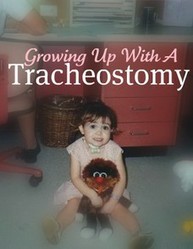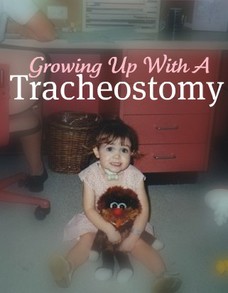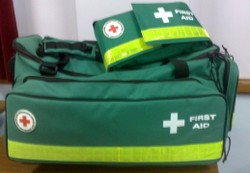I know what it's like to live with a tube in my throat to help me breathe properly, without ever expecting to have it removed.
I had a tracheotomy tube due to severe throat trauma at two and a half years of age. I had the tube for 11 years, up till the age of nearly 14 years. I stayed in hospital for three months after getting the tube inserted. For the first few weeks after the operation I lost my voice completely but slowly regained it, although it was much lower and breathier. I had several operations over the next few years to enlarge the hole as I grew.

Growing up with a Tracheostomy Tube
by wrylilt
Information about tracheostomy tubes, tips and a look at what they're like to live with.
What is a tracheostomy tube?
Basically a tracheotomy is the process of cutting a slit or hole in the trachea to allow the patient to breathe, often in such cases as neck injury or trauma and a range of throat problems including cancer. Often people who have problems with their voice box or vocal cords can end up wearing a tracheostomy tube.
In some cases the slit is made as a short term solution to the problem while in other cases the slit is used to insert a tracheostomy tube that a person uses to breathe through for months, years and in some rare cases, their life span.
The tube that is inserted into the hole is usually a white or cream color although some special types can come in other colors such as blue. Usually the tube curves downwards and is between 2-3 inches. The tube is held in place mostly by the throat but is often held on with linen tape tied around the neck.
Common Questions About Tracheostomies
Q:Will food and drink come out the hole?
No. The tube is inserted into the airway, not the oesophagus so it should never have any contact with any food or drink.
Q:Are all tracheostomy tubes one size?
No. The tube will vary in size depending on the size of the person and the type of trauma.
Q:What differences are there between a child having a tracheostomy tube and an adult having a tracheostomy tube?
In a child it can be more difficult to make sure the tube isn't moved or injured during normal childhood play. If a child has the tube for a long period of time, doctors may operate every few years to enlarge the hole and insert a larger tube to allow the child to be able to breath properly.
Q:Who can change a tracheostomy tube?
For short term tubes, usually a doctor or nurse will help change the tube. However in longer term use, a parent or friend will be shown the simple procedure to change the tube regularly.
Q:How often and what procedure is used to change a tracheostomy tube?
It's usually recommended that the tube be changed every 1-2 weeks. This simply involves cutting the linen tape that holds the tube in place, pulling the tube out then putting a clean one in place and tying it, inserting the tape through the holes provided on each side of the tube. The old tube is then sterilized and kept ready for the next change over. The tubes can be used this way for a reasonable period of time, until they start to appear worn or deteriorate.
Q:Are there any special attachments for tracheostomy tubes?
A small filter can be placed on the end of the tube to catch any phlegm or other fluids that are coughed up by the wearer. The filter is made of a simple slip on round tube with paper filters on each side. Once used the filter is thrown away and a new one put in its place. A healthy wearer can use one filter every 6-12 hours while a sick wearer may have to change it every time it fills up, every 10-20 minutes on average.
Various medical apparatus can also attach onto the tube such as ventilators.
Where am I Now?
Doctors believed I might never have the tube removed due to severe damage to my vocal cords. However I was one of the first people in Australia to have laser surgery (at the age of 13) which was followed by extensive healing and finally the removal of the tube. It took several more months before doctors agreed I was ready to have the hole permanently sewn over.
I had some minor plastic surgery when I was 16 to remove the majority of the scarring although I still retain a long horizontal line that stretches over halfway around my neck. My voice has improved although it is still high pitched, breathy and difficult for some people to understand and on the phone I am often mistaken for someone much younger.
Tips & Advice
Learning to live with or care for someone with a tube in their throat that requires special care can be a steep learning curve. Here are some things I've learnt from my experience.
- Be open with other people about the tube. Many people will make incorrect assumptions about it and often be too afraid to ask.
- Ask your local swimming pool about taking a rubber tube in for older children or adults who can't swim. Since water entering the tube or throat hole has a similar effect to water entering the mouth, most swimming pools will allow you to take in any special items you need to avoid going under water.
- Some schools may be a little worried about a student with a tracheostomy. Simply let them know that it needs no special extra care (in most cases) and if needed leave your child's doctors name and a few basic details of tracheostomy care with a school nurse.
- Some tracheostomy wearers may have trouble breathing correctly or breathe similar to an asthma sufferer under exertion. Although it may sound scary this is normal due to the tube going directly into the airway.
- Speech therapy can often help both the voice level as well as correct breathing (some tracheostomy wearers speak on the in breath instead of the out breath.)
- A simple silk scarf wrapped around the neck can be a great way to cover the tracheostomy.
Further Reading & Resources
Tracheostomy Group
A group on Facebook for those with or caring for a tracheostomy user.
Aaron's Tracheostomy Page
Complete guide to tracheostomies including famous people with tracheostomies and in depth information on breathing tubes.
You might also like
Painfree Arthritic Knees Without SurgeryAPOS therapy saved my life. I was on a fast downhill spin into disability, se...
First Aid: Would you Know What to Do?A medical emergency could happen at any moment. The question is whether you h...




 Do Solar Panels Work in Cloudy Weather or at Night?on 09/16/2020
Do Solar Panels Work in Cloudy Weather or at Night?on 09/16/2020
 Keyword Research - The Pitfalls, The Methods & How To Rank In Google For Freeon 04/21/2012
Keyword Research - The Pitfalls, The Methods & How To Rank In Google For Freeon 04/21/2012
 Are You Getting Married Too Young? Should You Wait?on 08/29/2012
Are You Getting Married Too Young? Should You Wait?on 08/29/2012
 Maplestory Islanders - What Are They & What's The Challenge?on 09/02/2012
Maplestory Islanders - What Are They & What's The Challenge?on 09/02/2012


Comments
I am really surprised there is not a children's book out yet about trach tubes to help explain to kids that they are not part alien...lol. I really think someone should write a book about living with one that is child friendly.
Hi my daughter also has damaged vocal cords so she has a Trach also. They have talked about layering her vocal cords to get the Trach out but I worry about aspiration...do u have any issues with aspiration?
What an experience for a child to have! Growing up can be difficult for anyone, but this must have made it even more of a challenge for you. Thank you for explaining your experience to us. I'm sure your story and your answers to common questions about growing up with a tracheostomy tube will help both fellow sufferers and those around them. Hats off to you! I'm glad you were able to benefit from laser surgery.
P.S. A beautiful silk scarf always looks so classy!